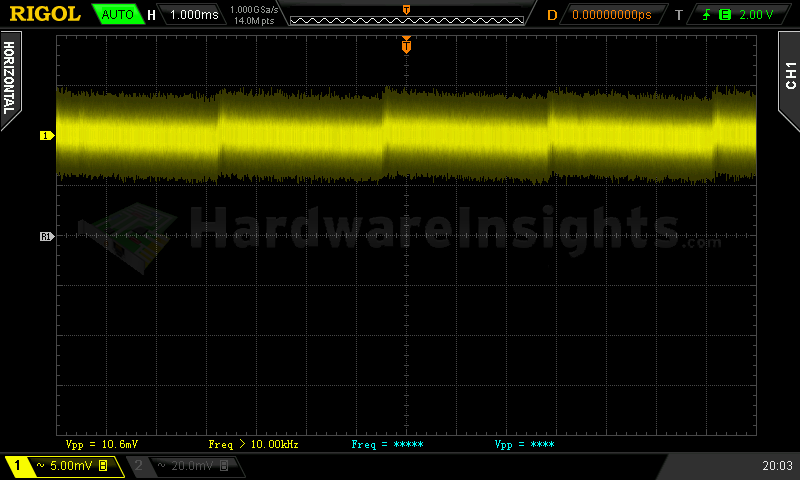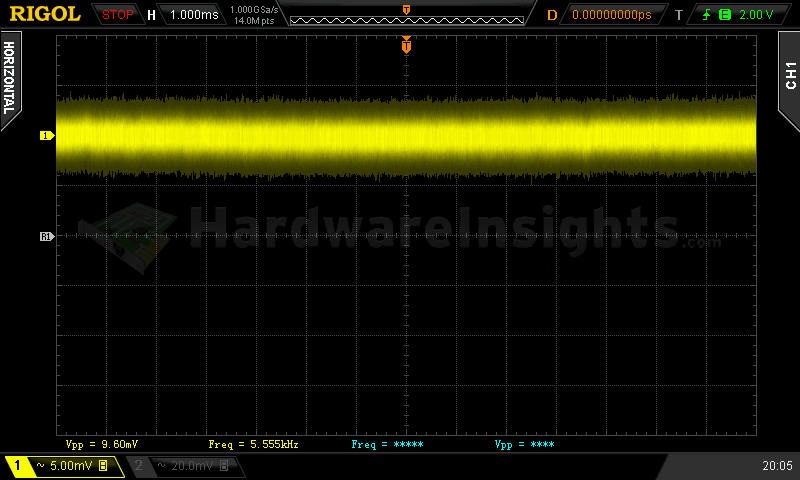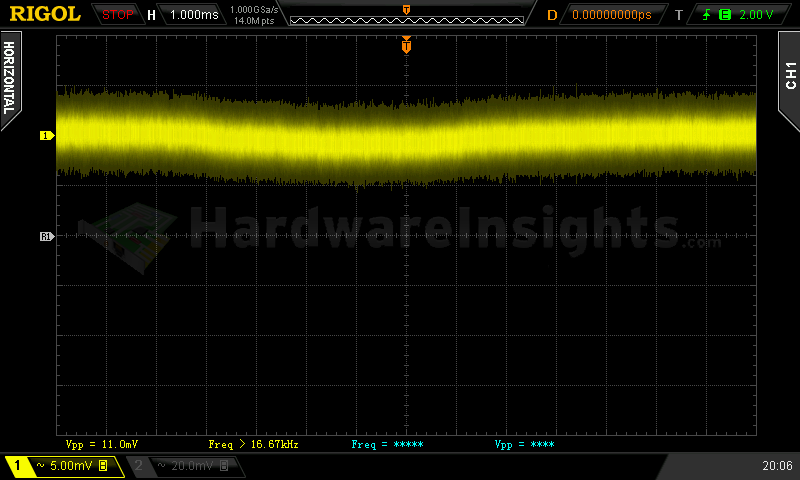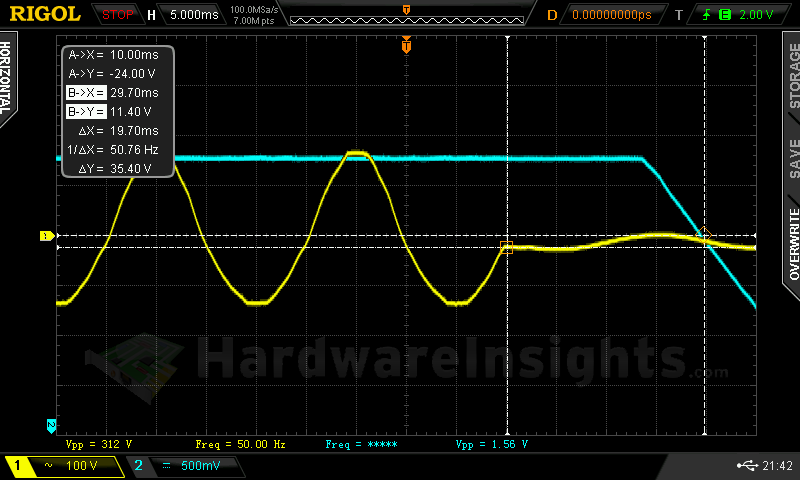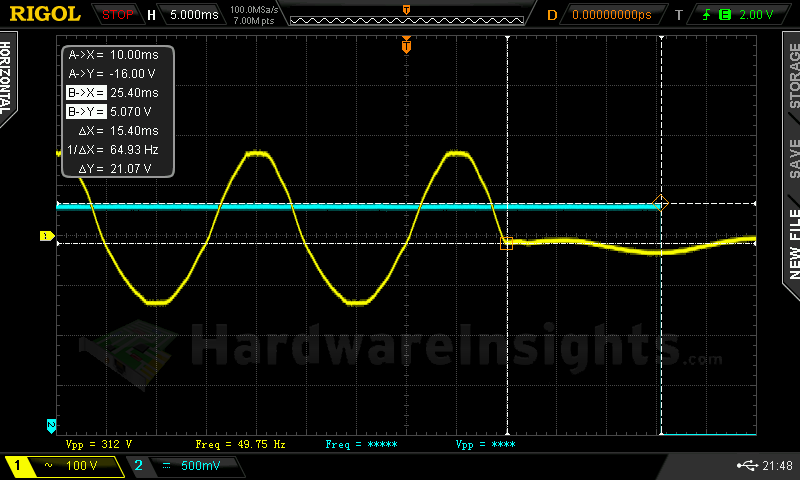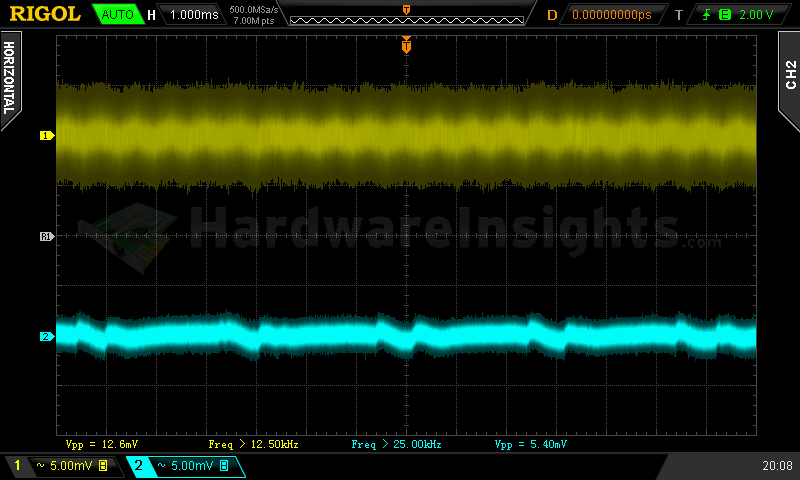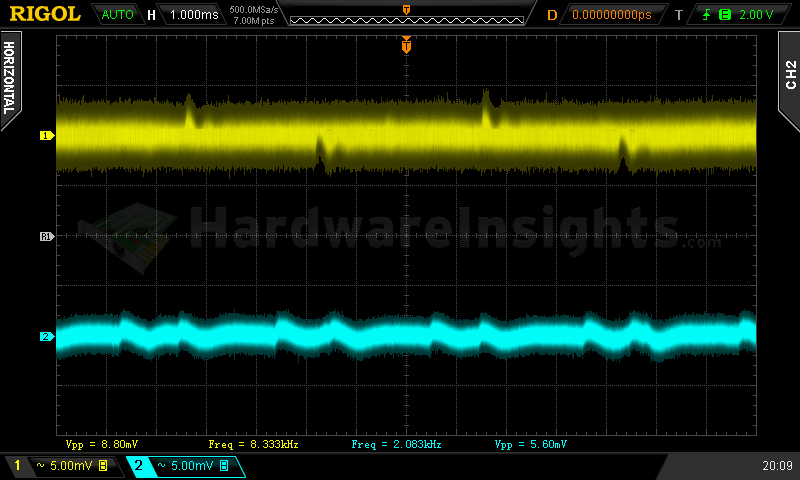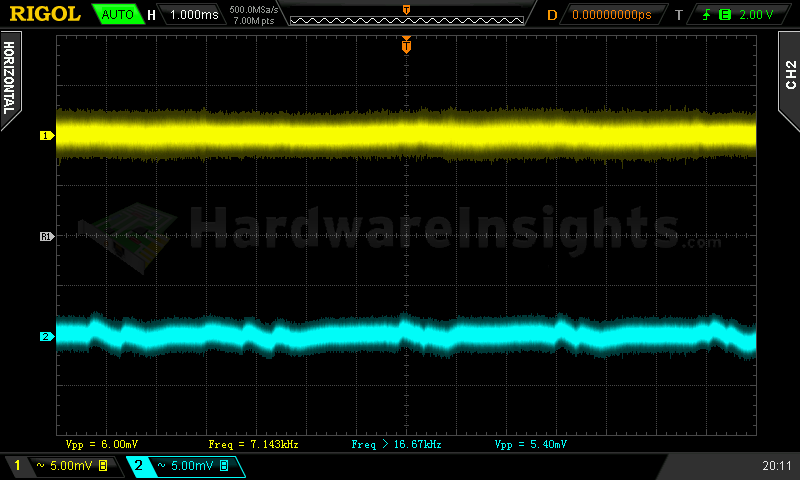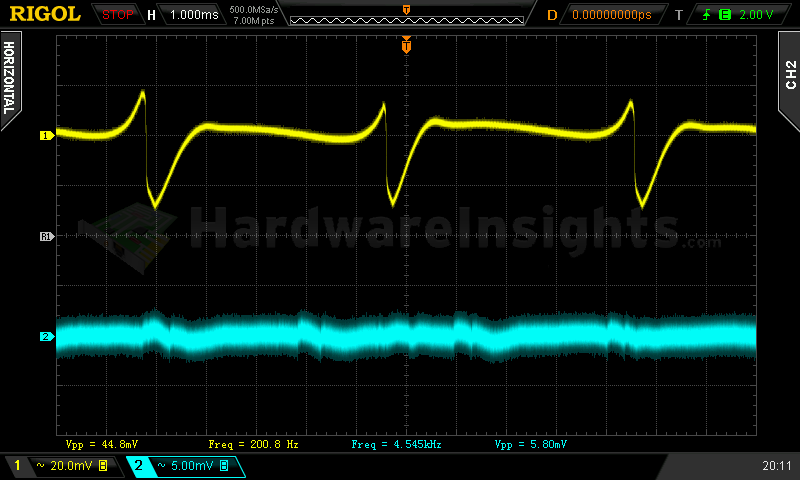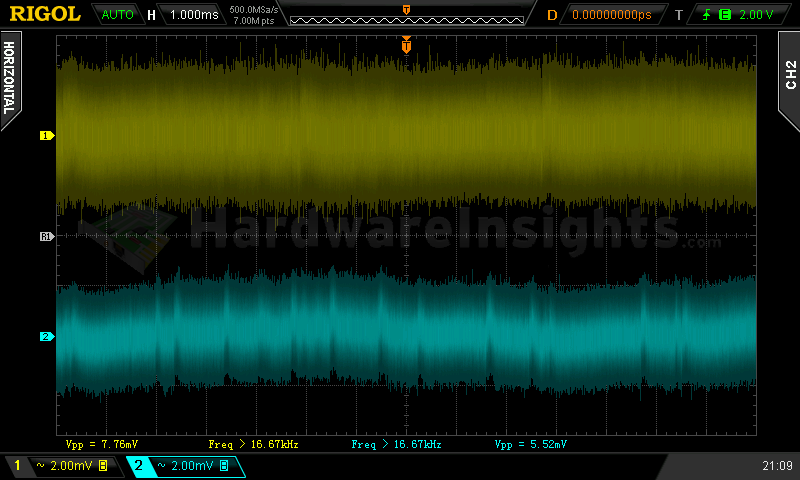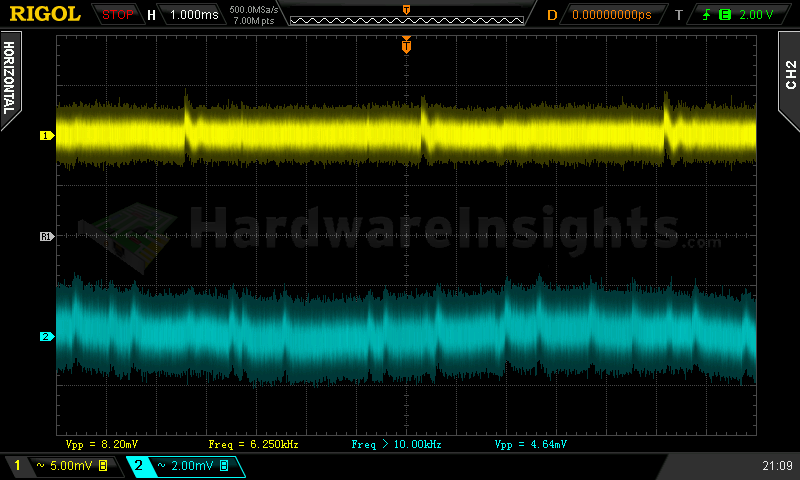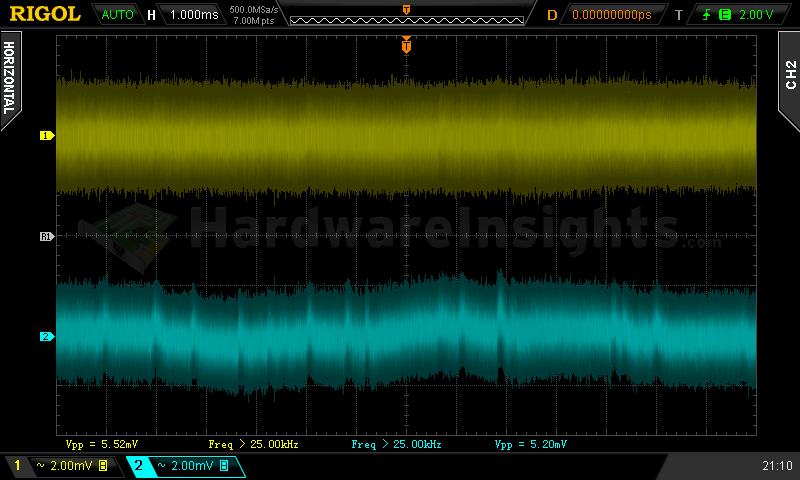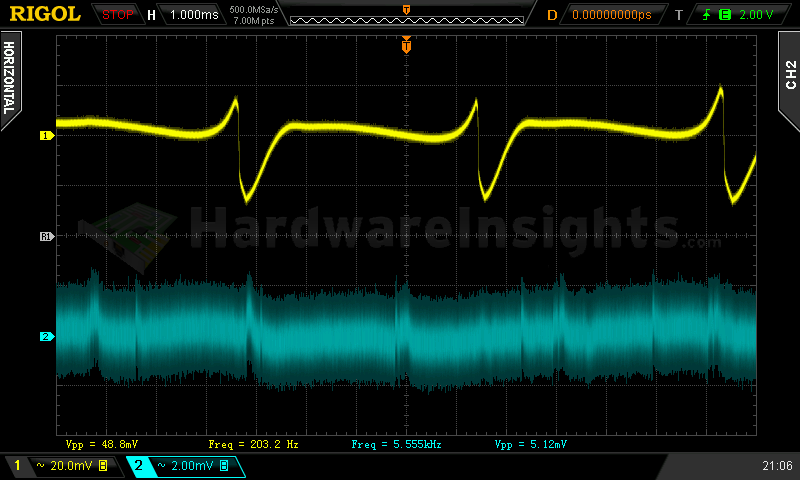Contents
- 1Introducing the Super Flower Leadex Platinum 750 W
- 1.1Packaging and accessories
- 2Connectors & cabling
- 2.1Casing & cooling
- 3Input filtering
- 4Primary side
- 4.1+5 V stand-by rail
- 5Secondary side
- 5.1Build quality
- 6Load testing
- 6.1Loading +5 V SB
- 6.2Voltage hold-up time
- 6.3Combined loading
- 6.4Combined loading ripple
- 6.5Crossloading, overloading
- 6.6Crossloading, overloading ripple
- 6.7Fan speed, temperatures and noise
- 7Conclusion and evaluation
- 7.1Thanks
- 7.2Discussion
Load testing
Loading +5 V SB
As always, all load testing is done according to our testing methodology. We see that the voltage regulation corresponds more with mainstream than high-end units, it is within ±3 %, but not within ±2 %.
| Output (W) | Load (A) | Voltage (V)/ ripple (mV) | Input (W) | Efficiency/power factor |
| 0 | 0 | 5.13/10.6 | 0 | —/0.004 |
| 12.27 | 2.45 | 5.02/9.60 | 16.54 | 74.2 %/0.475 |
| 16.89 | 3.41 | 4.96/11.0 | 22.73 | 74.3 %/0.530 |
Ripple suppression is just as bad here and the efficiency is under 75 %. Seems to me Super Flower has not really focused on the stand-by supply, most likely they think it is not so important as the rest of the unit. And if you think about it, in absolute values, it does not really matter if the unit draws 15 or 17 watts under 2.5A draw from the stand-by rail.
+5 V SB ripple (left to right): 0 A; 2.45 A; 3.41 A
Voltage hold-up time
As we can see on the oscilloscope screenshot, the hold-up time of the +12 V rail is good, precisely 19.7 ms. No problem here, however, trying to interrupt the power for 19.7 ms revealed there are some oscillations which drop under the ATX minimum of 11.4 V. And that is still not the worst.
Checking the Power Good signal revealed its hold-up time is only 15.4 ms. That actually corresponds much more with the real value necessary to keep the +12 V voltage in spec. So this is the unit’s true hold-up time, because if some drop in the power grid occurs and the PWR OK signal drops, your computer will restart (or stay turned off if the time is longer). This behaviour is in compliance with the ATX spec which dictates the PWR OK to drop out first to keep the voltage feed in spec untill the computer is turned off, however, this time difference is quite long and here the unit does not meet ATX minimum for Power Good signal!
Combined loading
Combined loading was OK for the Super Flower Leadex Platinum 750 W. Firstly, let’s talk about the voltage regulation. As this is a synchronously-rectified topology with DC-DC converters, the results are expected to be very good. As we have already established, the +5 V SB regulation could be better. While all the other rails showed regulation within ±2 %, there are already units on the market with regulation even tighter. These results are nice, however, I personally expected slightly better, being under constant bombardment of how great the Super Flower units are. The most troublesome here is clearly the +12 V rail which starts at 12.22 V, if it would have been lower, the overall results would also be better.
| Output power | Load/ voltage +5 V SB | Load/ voltage +3.3 V | Load/ voltage +5 V | Load/ voltage +12 V | Load/ voltage −12 V | Input power | Efficiency/ power factor |
| 3.9 %/ 29.51 W | 0 A/ 5.12 V | 0 A/ 3.30 V | 0.402 A/ 5.05 V | 1.854 A/ 12.22 V | 0.406 A/ −11.89 V | 42.83 W | 68.9 %/ 0.698 |
| 20 %/ 150.78 W | 0.541 A/ 5.09 V | 1.456 A/ 3.29 V | 1.586 A/ 5.04 V | 10.70 A/ 12.20 V | 0.395 A/ −11.91 V | 171.6 W | 87.9 %/ 0.926 |
| 40 %/ 305.57 W | 1.03 A/ 5.06 V | 2.81 A/ 3.28 V | 3.43 A/ 5.02 V | 22.1 A/ 12.18 V | 0.398 A/ −11.92 V | 339.5 W | 90.0 %/ 0.969 |
| 60 %/ 445.16 W | 1.55 A/ 5.03 V | 5.83 A/ 3.27 V | 4.93 A/ 5.01 V | 32.0 A/ 12.15 V | 0.403 A/ −11.93 V | 493.9 W | 90.1 %/ 0.981 |
|
80 %/ 593.23 W |
1.92 A/ 5.02 V | 8.40 A/ 3.27 V | 6.80 A/ 5.01 V | 42.5 A/ 12.17 V | 0.405 A/ −11.94 V | 658.0 W | 90.2 %/ 0.990 |
| 100 %/ 750.75 W | 2.40 A/ 4.99 V | 9.70 A/ 3.25 V | 9.41 A/ 4.99 V | 54.0 A/ 12.14 V | 0.400 A/ −11.95 V | 837.7 W | 89.6 %/ 0.992 |
As for the overall efficiency, we reached only slightly over 90 %, which is strange. We will have to wait for couple more units to see how the new UNI-T UTE1010A power meter goes, but this instrument should be much better than all that I previously used, so even this result should already be more believable. However, the overall efficiency seems to be lower. Well, I think it is still too soon to make any definitive judgements in this area with brand new power meter.
I searched for other reviews to find that mostly only 1kW and more powerful versions of this platform have been tested so we have no idea if this can actually be a platform problem or not. There is an article with the 750W version on eTeknix, which is considered a quality website by many, however, without trying to criticise much, that is far away from the truth. I lack crucial information in their Test Procedure (for example, what do they measure wall power draw with? on what voltage?) and they do not even know what they should actually measure (150 mV ripple on +12 and −12 V rails? Since when?). And that USB O-scope toy…oh well. There is even more. For these reasons, I will not link to that article.
Combined loading ripple
Two news items, lets start with the bad one. The filtration on the −12 V rail is not adequate for the 6W fan I am using. As a result, the ripple goes above 60 mV. Too bad. On the other hand, suppression on all the remaining rails is the best I have ever seen in my life. If I am looking right, only in two cases out of 24 the ripple went over 10 mV.
| Output % | Ripple +5 V SB | Ripple +3.3 V | Ripple +5 V | Ripple +12 V | Ripple −12 V |
| 3.9 | 12.6 mV | 6.0 mV | 8.8 mV | 5.8 mV | 44.8 mV |
| 20 | 5.44 mV | 5.44 mV | 5.84 mV | 5.80 mV | 67.2 mV |
| 40 | 6.64 mV | 2.56 mV | 5.36 mV | 5.12 mV | 61.6 mV |
| 60 | 4.88 mV | 5.44 mV | 6.24 mV | 5.76 mV | 37.6 mV |
| 80 | 4.00 mV | 6.24 mV | 10.00 mV | 5.36 mV | 58.4 mV |
| 100 | 7.76 mV | 5.52 mV | 8.20 mV | 5.20 mV | 48.8 mV |
That is under 10 mV within 90 % of measured cases. I think it is time to give the unit three extra points for this result. My evaluation methodology simply does not implement logaritmic scale which would be the best one to evaluate such results. Because if you stop and think about it, the closer you want to get to 0 mV, the harder it gets, so it is only fair to award such results. After all, the unit is going to loose points for the poor −12 V performance anyway…
Ripple 3.9% load (left to right): +5 V SB; +3.3 V; +5 V; −12 V. The second channel is connected to +12 V.
Ripple 100% load (left to right): +5 V SB; +3.3 V; +5 V; −12 V. The second channel is connected to +12 V.
Crossloading, overloading
Crossloading tests went fine, as could be expected from platform utilizing DC-DC converters. The voltage regulation was mostly the same. Efficiency dropped further, even under 80 % with crossload of +3.3 V rail. But here the same applies for the new power meter, let’s give it some time. Overloading any separate rail was futile, as well as trying the sweater – I did not even do it, you will see why later. But the OTP itself works, the unit turned off slightly after 13 minutes. Upon turning it on again, the temperature was over 35 °C for a while and the fan rotated at full speed (over 1700 RPM).
| Output power | Load/ voltage +5 V SB | Load/ voltage +3.3 V | Load/ voltage +5 V | Load/ voltage +12 V | Load/ voltage −12 V | Input power | Efficiency/ power factor |
| 13 %/ 78.01 W | 0.550 A/ 5.09 V | 19.94 A/ 3.29 V | 0.399 A/ 5.04 V | 1.836 A/ 12.22 V | 0.384 A/ −11.93 V | 124.9 W | 78.1 %/ 0.897 |
| 18 %/ 134.17 W | 0.549 A/ 5.09 V | 1.445 A/ 3.29 V | 19.8 A/ 5.01 V | 1.848 A/ 12.22 V | 0.393 A/ −11.94 V | 162.1 W | 82.8 %/ 0.920 |
| 99 %/ 742.06 W | 0.534 A/ 5.07 V | 1.440 A/ 3.27 V | 0.411 A/ 5.02 V | 59.9 A/ 12.15 V | 0.403 A/ −11.93 V | 826.1 W | 89.8 %/ 0.993 |
| 140 %/ 1050.69 W | 3.31 A/ 4.91 V | 22.8 A/ 3.23 V | 28.5 A/ 4.95 V | 67.3 A/ 12.11 V | 0.393 A/ −12.01 V | 1227 W | 85.6 %/ 0.994 |
Overloading the Leadex Platinum 750 W was a nightmare. I throwed everything I got against it, and it was still standing! At 1.05 kW! However, from the +12 V waveform was obvious I am pretty close. It was only when I connected an extra 1.35A fan which finally made it stop (most likely because of the startup current spike). So we can see it can make as much as over 300 W extra, but the efficiency drops further.
Crossloading, overloading ripple
This time only the +12 V ripple went over 10 mV, and that was when the regulation was nearing its designed maximum power output.
| Output % | Ripple +5 V SB | Ripple +3.3 V | Ripple +5 V | Ripple +12 V | Ripple −12 V |
| 13 | 9.00 mV | 8.08 mV | 8.08 mV | 4.80 mV | 48.8 mV |
| 18 | 7.28 mV | 4.64 mV | 6.80 mV | 4.64 mV | 52.0 mV |
| 99 | 7.68 mV | 4.80 mV | 7.04 mV | 6.88 mV | 43.6 mV |
| 140 | 8.58 mV | — | — | 20.4 mV | — |
Fan speed, temperatures and noise
When in ECO mode, the fan of the Leadex Platinum 750 W started spinning not sooner than in test 6, that is under approx. 100% load, at about 860 RPM. It is worth noting that with somewhat better thermometer, I can now measure actual temperature and not some wishful thinking so we can see the intake air was quite cold. The reason is I have to feed miners with fresh and cold air ![]() When in AUTO mode, it started right away at 940 RPM and slightly increased almost each test. Immediately after testing OTP (thus overheating the unit), the unit’s fan was spinning at over 1700 RPM. Then the noise reaches as much as 46.7 dBA.
When in AUTO mode, it started right away at 940 RPM and slightly increased almost each test. Immediately after testing OTP (thus overheating the unit), the unit’s fan was spinning at over 1700 RPM. Then the noise reaches as much as 46.7 dBA.
| Output % | Fan speed (RPM) | Temperature intake/ outtake | Noise (dBA) |
| 3.9 | 0/941 | 14 °C/ 14 °C | —/39.1 |
| 20 | 0/1001 | 15 °C/ 17 °C | —/39.2 |
| 40 | 0/1040 | 16 °C/ 19 °C | —/39.3 |
| 60 | 0/1130 | 16 °C/ 20 °C | —/39.9 |
| 80 | 0/1133 | 17 °C/ 22 °C | —/39.9 |
| 100 | 863/1220 | 18 °C/ 24 °C | 39.0 /40.5 |
| CL 13 | 0/958 | 15 °C/ 15 °C | —/39.1 |
| CL 18 | 0/992 | 15 °C/ 21 °C | —/39.2 |
| CL 99 | 862/1348 | 19 °C/ 26 °C | 39.0 /41.8 |
| OL 140 | 1260/1560 | 21 °C/ 32 °C | 40.7 /44.6 |
As for the noise, in a silent room with 38.8 dBA ambient, the fan is really noisy at 1500-1700 RPM. Then the noise decreases and under 1200 RPM it becomes tolerable, but even at minimum 860 RPM it is still audible. It is something like aerodynamic noise together with kind of hissing, in my opinion coming from the ball bearing. In most ordinary configurations you will likely not hear it though. But after all, the talk is true: in supersilent configurations, when the fan finally starts spinning, it is definitely audible. The higher the speed, the worse it gets. And the higher the temperature, the higher the speed, here the fan control works stoutly.
